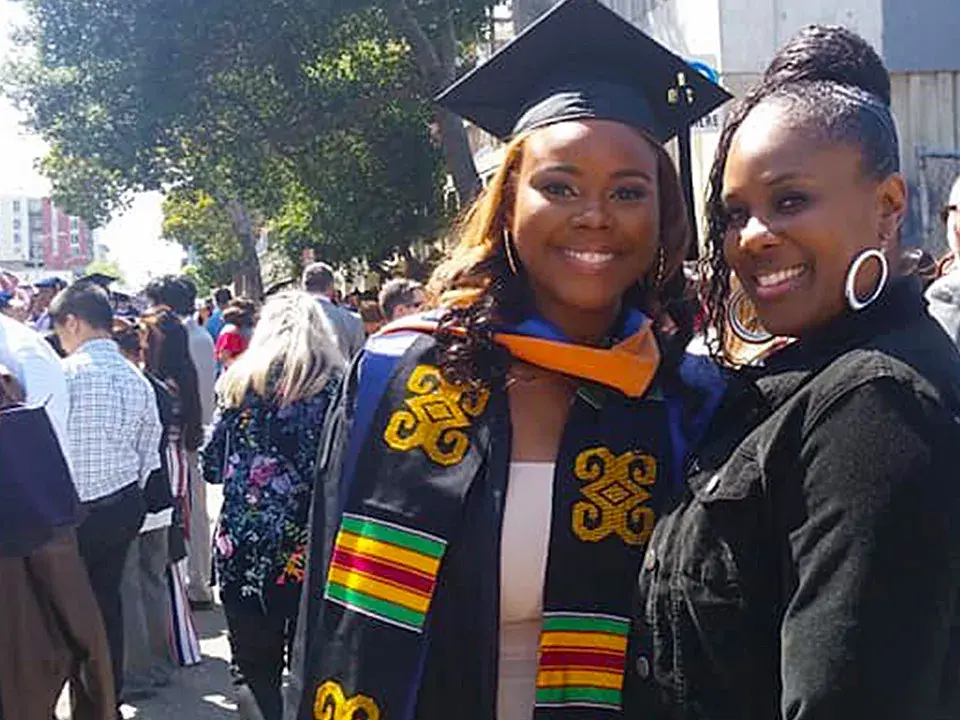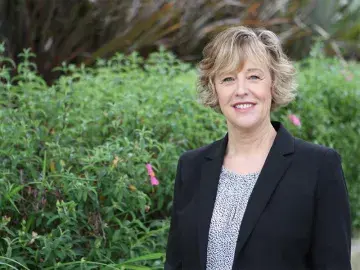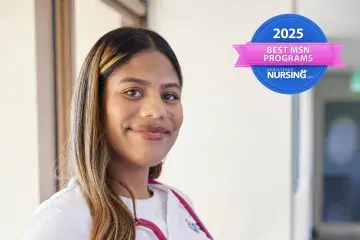Renewed Grant Expands Support for Students from Diverse Backgrounds

Only a few months after graduating from Samuel Merritt University, Aariona Wysinger, BSN ’19, was working at her dream job as a nurse at Johns Hopkins Hospital, caring for a patient she’ll never forget—a man in his 70s suffering from life-threatening bleeding caused by acute leukemia.
“One minute we were holding his blood count stable, the next he was doing much worse,” says Wysinger. “We all knew he was going to pass, but he and his wife wanted to prolong his life as long as possible. In addition to providing clinical care like giving him blood products, I was able to support them by listening to their concerns and making sure they understood his care plan.”
Wysinger admits to feeling a little intimidated when she started at Johns Hopkins so soon after graduating from SMU's Bachelor of Science in Nursing program. But once she got to work at the top-three ranked hospital in the nation, she drew from her SMU experience and quickly rose to the challenge.
“At SMU, I learned to be overly prepared,” she remembers. “At Johns Hopkins, I used to come to work early to learn about my patients in advance. I would think of everything that might happen, not just wait for it to happen. I also learned to be proactive in nursing school, and now I seek all the information I can so I can make the best choices for my patients.”
Diversity initiative paves the way
Wysinger tracks her success back to SMU’s Office of Diversity and Inclusion, where the staff encouraged her to apply to the Nursing Workforce Diversity (NWD) Program—what she recalls as one of her most meaningful SMU experiences.
In the NWD, she was part of a national grant-funded initiative to grow the number of African American and Latinx nurses. In California, 5% of nursing school graduates are Black compared to 6% of the general population, and only 26% of nursing school graduates are Latino compared to 39% of the population. Nationally, 10% of nurses are Black compared to 13% of the general population, and 5% of nurses are Latino compared with 19% of the general population.
Since 2016, SMU has received $1.8 million in federal grant funds for the NWD to offer a series of support initiatives: weekly tutoring to improve their study skills; monthly counseling to help with balancing school, clinicals, and family expectations; mentoring with a practicing nurse; scholarship funds; a monthly stipend so they can work less during school; and regular meetings with other NWD recipients and leaders.
To date, 55 NWD participants have graduated—all on time. And 64 additional African American and Latinx nursing students are expected to participate in the NWD at SMU over the next four years, thanks to a new cycle of $2.2 million in recently approved funding from the U.S. Department of Health and Human Services.
“The NWD took away a lot of the stress and anxiety I felt,” says Wysinger, who grew up in Richmond and Sacramento as the daughter of a cosmetologist and longshoreman. “A lot of doing well in nursing school is about being able to balance the emotional rollercoaster. Having a supportive group of students and faculty made it a lot easier when I was facing the pressure of passing my exams and boards.”
“Money alone would not make our students successful”
Nursing Professor Paulina Van, who led the first NWD grant before it was recently transitioned to Assistant Professor Shelitha Campbell, says NWD participants encounter challenges such as navigating uncharted waters as first-generation college students without a role model, financial insecurity and the need or expectation to balance family responsibilities, academic workload, and often employment. They also face institutional challenges like exclusion and biases and a minimal awareness of the familial, social, cultural, or religious backgrounds that impact their academic experiences, she says.
“Being an underrepresented student within a higher education setting has many tentacles, and we knew that money alone would not make our students successful,” says Van. “I know that from my personal experiences as well, since my parents set high expectations for me academically and helped me financially, but they didn’t provide much academic support for me along the way. That's why we designed the NWD with a focus on professional nurse mentoring, tutoring by alumni, and skills our students needed to adjust to the nursing profession. We're helping these students garner the life skills they'll need and use for the rest of their lives.”
Wysinger started at Johns Hopkins in an oncology step-down position, where patients need less care than an ICU but more than a traditional medical-surgical floor. After a year, she moved to a surgical ICU. When she found herself ready for a new challenge, she spent several months as a travel nurse in Northern California and the Central Valley during the pandemic. She’s now a telemetry nurse at Redwood City Kaiser, where she cares for patients in critical care who need constant monitoring, and an infusion nurse at San Francisco General Hospital, focusing on administering intravenous medications.
“Samuel Merritt taught me about the importance of having integrity and a strong work ethic and gave me the confidence that I can do what I want to do—like move across the country to work at Johns Hopkins,” says Wysinger.
“Life is about building relationships with people who genuinely support you,” she adds. “You take tests in school and move on, but the relationships last. I’m grateful for my Samuel Merritt professors who encouraged me and the friends I made at Johns Hopkins, who’ll be my friends for life.


